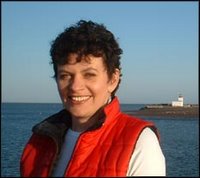 Here's a peculiar sign that often catches the interest of passersby in the village of Grand Pre, Nova Scotia; it says: "GRAND PRE DYKE 3013 acres below sea level"
Here's a peculiar sign that often catches the interest of passersby in the village of Grand Pre, Nova Scotia; it says: "GRAND PRE DYKE 3013 acres below sea level"
Now, you may wonder exactly how this can be so read on "...behind 28455 feet of dyke."
The fact is: a high proportion of our most fertile coastal farmland around the Bay of Fundy is actually reclaimed salt marsh. What's even more interesting is that many of these dykes were constructed in the 1700s by our earliest European settlers (who became the Acadians) from France.
Although some of these dykes eventually eroded so that several low-lying areas reverted to salt marshes, hundreds of miles of dyked farmland still exists in the upper part of the Bay in Nova Scotia and New Brunswick.
If you know what you are looking at you can see dykes in dozens of coastal, flat field locations quite clearly as you drive or walk by. In some communities, such from Wolfville to Canning, Nova Scotia, the top ridge of the dyke has become a popular walking & mountain biking trail!
Wednesday, June 25, 2008
Farmland below sea level?
Subscribe to:
Post Comments (Atom)






1 comment:
In my part of Nova Scotia the difference between low tide and high tide can be as little as one meter or so. Along parts of the Bay of Fundy especially near Truro and Moncton the difference can be over 15 meters. The question has crossed my mind, if ocean levels were to rise 30 cms in my area, would high tide levels along parts of the Bay of Fundy rise by 4.5 meters?
30 cms x 15 = 450 cms/ 4.5 meters.
One of the best types of responses to this may be initiatives such as the Sahara Forest Project.
Post a Comment